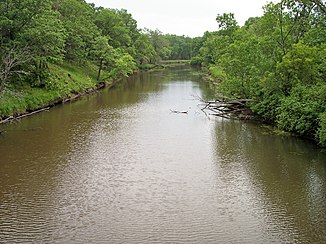Saint Francis River (Elk River)
| Saint Francis River | ||
|
Saint Francis River within the Sherburne National Wildlife Refuge (2007) |
||
| Data | ||
| Water code | US : 650587 | |
| location | Minnesota (USA) | |
| River system | Mississippi River | |
| Drain over | Elk River → Mississippi River → Gulf of Mexico | |
| source |
Alberta Township , Benton County 45 ° 48 ′ 29 ″ N , 93 ° 53 ′ 31 ″ W. |
|
| Source height | 380 m | |
| muzzle | in the Elk River , Big Lake Township , Sherburne County Coordinates: 45 ° 21 ′ 33 " N , 93 ° 44 ′ 14" W 45 ° 21 ′ 33 " N , 93 ° 44 ′ 14" W |
|
| Mouth height | 278 m | |
| Height difference | 102 m | |
| Bottom slope | 0.89 ‰ | |
| length | 115 km | |
The Saint Francis River is a 115 km long tributary of the Elk River in eastern Minnesota in the United States . Over the Elk River it is part of the catchment area of the Mississippi River and drains an area that was previously overgrown mainly by hardwoods and conifers and consists of a flat to undulating ground moraine landscape .
The Saint Francis River rises in Alberta Township in northeast Benton County and flows generally south through the east of the county past Foley . A small tributary flows into it, known as the West Branch St. Francis River . Once in northern Sherburne County , the river turns east and later flows south and southwest through the Sherburne National Wildlife Refuge and Sand Dunes State Forest. It flows into the Elk River in Big Lake Township in the south of Sherburne County, about two kilometers north of the city of Big Lake .
History and Conservation
People had lived in the Saint Francis River valley for more than ten thousand years. North American Indian settlements in the Sherburne National Wildlife Refuge date back to around 1300. More recently, the area was settled under the Homestead Act during the 1870s .
Originally, the basin of the St. Francis River one of the richest game areas in Minnesota, where thanks to the large number of small lakes and flood plains near the river and the surrounding Vergation with wild rice and other wetland plants large amounts of wild ducks , muskrats , beavers and mink one had a good living. The surrounding high banks were habitat for elk , bison and gray wolves . By the middle of the 20th century, various influences had greatly reduced the value of the habitat for animals and plants. Wetlands were drained by drainage ditches built in the 1920s to increase the agricultural area. During the early 1940s, carp invaded the region's lakes and rivers. Their feeding behavior led to the existing vegetation being overturned, which was important for the abundance of game in the water. In addition, the original oak savannahs have been converted into agricultural areas or residential areas. In 1965 the Sherburne National Wildlife Refuge was established in an attempt to restore the original habitat for wildlife on the St. Francis River.
Web link
See also
Individual evidence
- ↑ National Assessment Database: Assessment Data for the State of Minnesota in 2004. Year . United States Environmental Protection Agency . S. Clearwater-Elk Watershed . Archived from the original on July 7, 2007. Info: The archive link was automatically inserted and not yet checked. Please check the original and archive link according to the instructions and then remove this notice. Retrieved June 8, 2007.
- ↑ St. Francis River ( English ) In: Geographic Names Information System . United States Geological Survey . Retrieved February 16, 2011.
- ^ Upper Mississippi River Basin. . Minnesota Pollution Control Agency. S. Upper Mississippi River Basin Water Quality Plan Summary, Headwaters to the Rum River at Anoka . January 2004. Archived from the original on June 18, 2007. Retrieved June 8, 2007.
- ↑ West Branch St. Francis River ( English ) In: Geographic Names Information System . United States Geological Survey . Retrieved February 16, 2011.
- ^ Minnesota Atlas & Gazetteer . DeLorme , Yarmouth, Me. 1994, ISBN 0-89933-222-6 , pp. 28-29.
- ↑ a b Sherburne National Wildlife Refuge. . United States Fish and Wildlife Service . S. History . Retrieved June 8, 2007.
